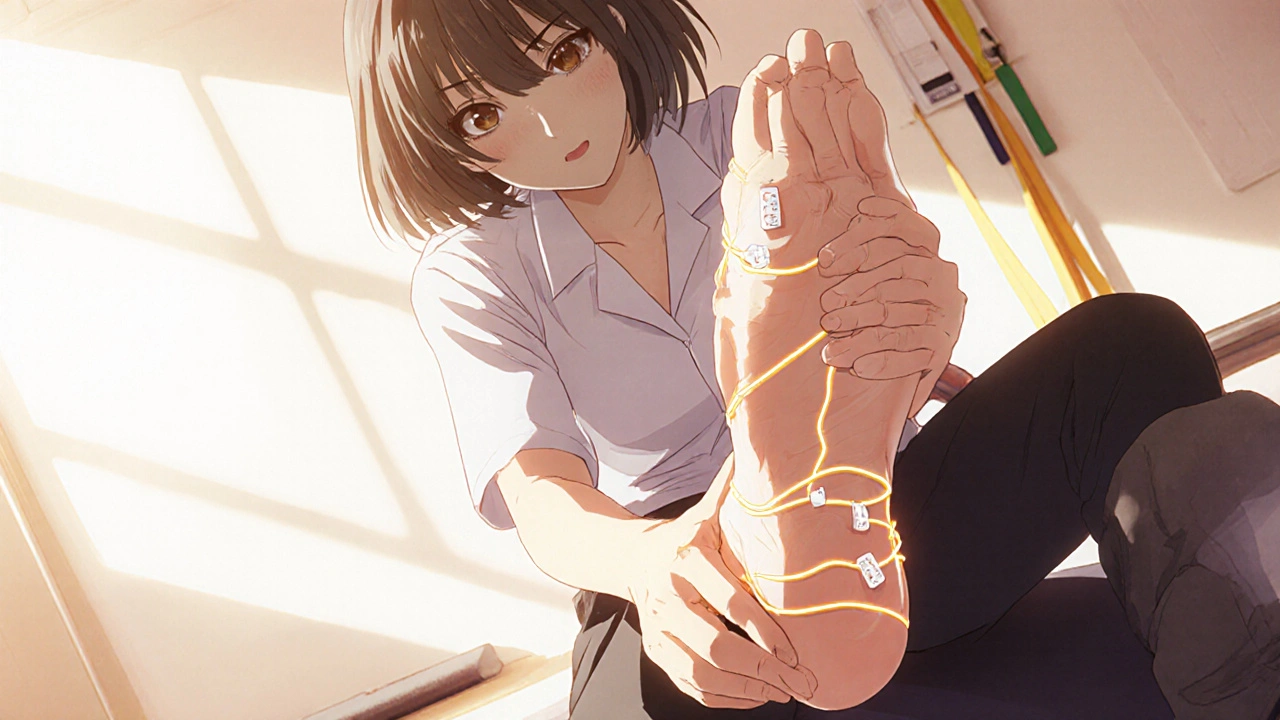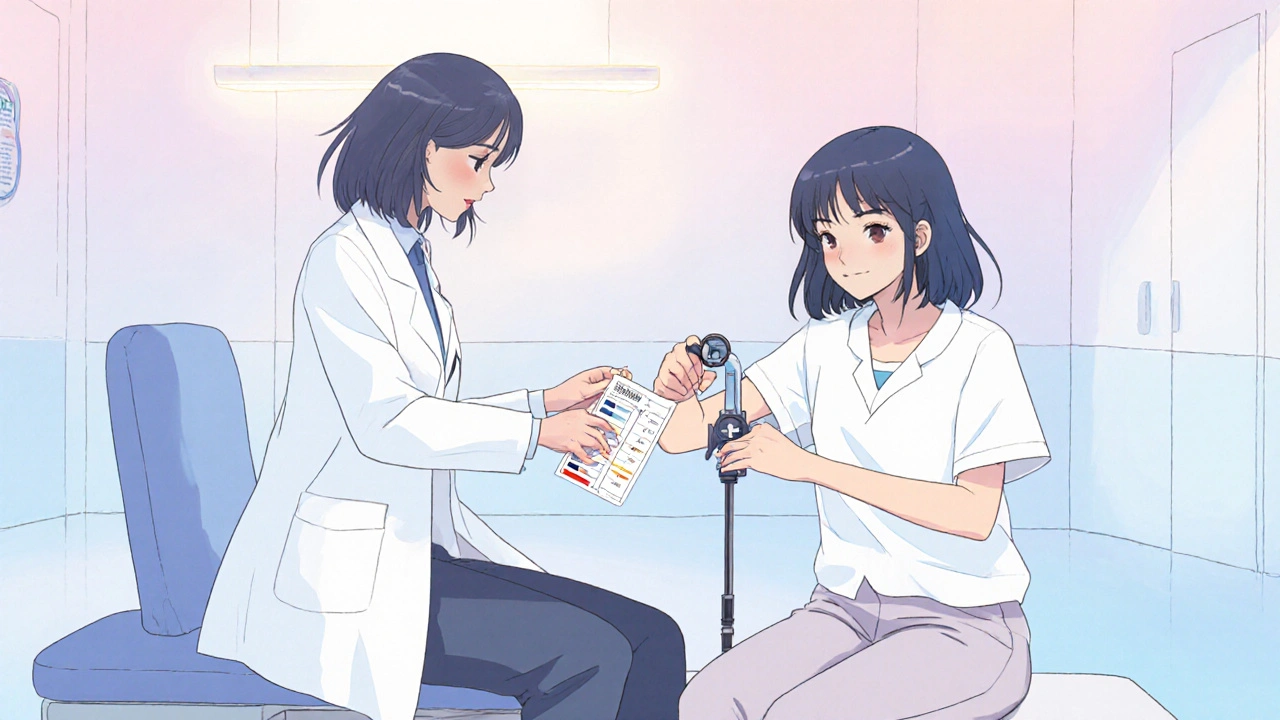Quick Takeaways
- Spastic muscle states result from nerve damage that leaves muscles overly tight.
- Physical therapy targets tone, strength, and movement patterns.
- Stretching, strengthening, positioning, and neuromuscular re‑education are the core tools.
- Assessments like the Modified Ashworth Scale guide goal‑setting.
- Combining PT with medication or Botox often yields faster gains.
When dealing with tight, uncontrolled muscles, Physical Therapy is a hands‑on rehabilitation approach that uses movement, exercise, and manual techniques to improve muscle function and reduce excess tone. It’s the first line of defense for anyone diagnosed with a spastic muscle state, whether the cause is cerebral palsy, multiple sclerosis, stroke, or spinal cord injury.
Spasticity isn't just a fancy medical term. It describes muscles that stay contracted even when you're not trying to move them. The result is stiff joints, awkward gait, and a higher risk of contractures. Understanding what spasticity looks like helps you see why targeted therapy matters.
What Exactly Is a Spastic Muscle State?
In simple terms, a spastic muscle state occurs when the brain or spinal cord can't properly signal a muscle to relax. The nerve pathways that normally balance excitation and inhibition become skewed, leaving the muscle in a semi‑permanent contraction. Common signs include:
- Velocity‑dependent resistance to passive stretch
- Clonus - rapid, rhythmic muscle jerks
- Hyper‑reflexia - over‑active reflexes
- Limited range of motion
Clinicians often grade spasticity with the Modified Ashworth Scale (0‑4). A score of 2 means a noticeable catch during slow stretch; a 4 indicates a rigid joint that can't be moved at all.
How Physical Therapy Tackles Spasticity
Physical therapy works on three fronts: reducing excess tone, restoring functional movement, and preventing secondary problems like contractures or joint degeneration. The magic lies in repeated, purposeful movement that retrains the nervous system.

Core PT Techniques for Spastic Muscles
Below is a quick snapshot of the most common interventions. Each one hits a different piece of the spasticity puzzle.
| Technique | Primary Goal | Typical Session Length | Key Benefit |
|---|---|---|---|
| Passive Stretching | Lengthen shortened muscle fibers | 10‑15 min | Improves joint range, reduces contracture risk |
| Active‑Assist Strengthening | Build strength in antagonist muscles | 20‑30 min | Balances tone, supports functional tasks |
| Positioning & Orthotics | Maintain neutral alignment | 5‑10 min (setup) | Prevents permanent deformity, eases care |
| Neuromuscular Re‑education | Retrain brain‑spinal pathways | 15‑20 min | Improves voluntary control, reduces reflexes |
| Electrical Stimulation (NMES) | Activate weak muscles safely | 10‑15 min | Boosts strength without excessive effort |
1. Passive Stretching
Therapists move the limb slowly through its full range while the patient relaxes. The stretch is held for 30‑60 seconds, repeated 3‑5 times per joint. Consistency matters - daily home‑stretch programs often produce the biggest gains.
2. Active‑Assist Strengthening
Spastic muscles tend to dominate, leaving opposite (antagonist) muscles weak. Using resistance bands, therabands, or weight‑bearing exercises helps the weak side push back. Even a few minutes of standing on a wobble board can fire up ankle dorsiflexors and improve gait.
3. Positioning & Orthotics
Strategic positioning (e.g., 30° hip flexion, neutral knee) reduces stretch‑induced spikes in tone. Custom orthoses keep joints aligned during sleep or wheelchair travel. The goal is to keep muscles at a length where they're less likely to reflexively contract.
4. Neuromuscular Re‑education
Techniques like the Bobath approach, Proprioceptive Neuromuscular Facilitation (PNF), and task‑specific gait training fall under this umbrella. Therapists cue the patient to initiate movement, then guide the limb to complete the action, reinforcing proper pathways.
5. Electrical Stimulation (NMES)
Low‑frequency currents are placed on weakened muscles (often the ankle plantarflexors). The pulse causes a gentle contraction, mimicking voluntary effort. Over weeks, the muscle gains strength and the nervous system learns a new firing pattern.
Designing a Personalized Treatment Plan
Every spasticity case is unique, so therapists start with a thorough assessment.
- History & Goal Setting - Understand the patient's daily challenges and long‑term ambitions (e.g., walking to the mailbox).
- Objective Measures - Use the Modified Ashworth Scale, range‑of‑motion goniometry, and gait analysis to baseline the problem.
- Program Frequency - Most adults benefit from 2‑3 sessions per week; children often need daily home exercises.
- Progress Monitoring - Re‑score spasticity every 4‑6 weeks; adjust stretching duration or add strengthening as tone improves.
A typical weekly schedule might look like:
- Monday: Passive stretching + NMES
- Wednesday: Strengthening + positioning review
- Friday: Neuromuscular re‑education gait drills
Home practice fills the gaps. Even 10 minutes of morning stretching can keep joints supple.
Managing Common Challenges
Pain & Discomfort
Stretching can trigger a brief ache when the muscle is very tight. Therapists use heat packs before the session and gentle oscillatory movements to ease the rise in tone.
Fatigue
Spastic muscles waste energy. Short, high‑frequency bouts (e.g., 5 minutes of NMES) often produce more benefit than long, exhausting stretches.
Adherence
Remember, therapy works best when it feels useful. Turning stretching into a game for kids or linking exercises to a favorite TV show for adults improves compliance.

When to Combine PT with Other Interventions
Physical therapy rarely works in isolation. Here are the most common adjuncts:
- Botulinum toxin (Botox) - Injected into over‑active muscles, it temporarily reduces tone, giving PT a clearer window to stretch and strengthen.
- Oral Antispasticity Meds - Baclofen or Tizanidine can lower baseline tone, but side effects like drowsiness may limit PT intensity.
- Selective Dorsal Rhizotomy (SDR) - A surgical option for severe pediatric cases; PT is crucial post‑op to relearn movement patterns.
Coordinating with a neurologist or physiatrist ensures timing aligns - for example, scheduling a PT session 2‑3 days after a Botox injection when the toxin is taking effect.
Tips for Patients & Caregivers
- Keep a daily log of stretch times and any changes in tone.
- Use a timer during home exercises - consistency beats occasional marathon sessions.
- Wear loose clothing that doesn’t restrict movement during therapy days.
- Stay hydrated; dehydration can worsen spasticity.
- Ask the therapist to demonstrate each stretch so you can replicate it correctly at home.
Frequently Asked Questions
How long does it take to see improvement?
Most people notice a reduction in tone within 4‑6 weeks of consistent PT, but functional gains (like walking longer distances) often need 3‑6 months of dedicated work.
Is stretching alone enough?
Stretching helps keep joints mobile, but without strengthening the opposite muscles, spasticity can return quickly. A balanced program yields lasting results.
Can children with cerebral palsy benefit from the same PT techniques?
Yes. Children often use play‑based versions of stretching, strengthening, and neuro‑re‑education. Early intervention is linked to better motor outcomes later in life.
What role does the Modified Ashworth Scale play in therapy?
Therapists use the scale to quantify spasticity, set measurable goals (e.g., drop from a score of 3 to 2), and track progress across weeks.
Are there any risks with electrical stimulation?
When applied correctly, NMES is safe. The main caution is to avoid placing electrodes over damaged skin or near implanted electronic devices.
Physical therapy isn't a quick fix, but it offers a practical, evidence‑based road out of the stiffness that comes with spastic muscles. By combining targeted stretches, strength work, and smart positioning, you can reclaim movement, reduce pain, and improve everyday independence.

Joanne Ponnappa
October 22, 2025 AT 20:17Great overview, thanks for sharing! 😊
Sarah Riley
October 25, 2025 AT 03:50The neurophysiological substrate of spasticity mandates a multimodal therapeutic paradigm.
Sajeev Menon
October 27, 2025 AT 10:23Physical therapy truly reschapes the nervous pathways when applied consistently.
Stretching releases the tight fibers, while strengthening the antagonists gives them something to push against.
I've seen patients progress from a Modified Ashworth score of 3 down to 1 after a few months of structured home routines.
Remember to log each session; the data helps tweak the program.
Keep the muscles active even on off‑days, the nervous system loves repetition.
Emma Parker
October 28, 2025 AT 14:10Lol I totally get how annoying those tight calves can be, I bet you feel like a robot sometimes! Let’s smash those stretches together!
Joe Waldron
October 30, 2025 AT 21:43When tackling spasticity, start with a thorough assessment, noting the Modified Ashworth score, range of motion, and functional goals; this baseline guides the entire program.
Next, incorporate passive stretching, holding each stretch for 30–60 seconds, repeating three to five times per joint, which gradually lengthens the muscle fibers.
Follow with active‑assist strengthening, using resistance bands or weight‑bearing tasks, to build the antagonist muscles, thereby balancing tone.
Positioning and orthotics should be evaluated daily, ensuring neutral alignment during sleep and wheelchair use, which prevents contractures.
Neuromuscular re‑education drills, such as task‑specific gait training, reinforce proper neural pathways, and should be practiced several times a week.
Electrical stimulation can be added as a supplemental tool, applied for 10–15 minutes per session, to activate weak muscles without excessive effort.
Consistency is key; daily home exercises, even ten minutes, yield more progress than occasional marathon sessions.
Finally, monitor progress every 4–6 weeks, adjusting the plan based on objective measures and patient feedback.
Wade Grindle
November 1, 2025 AT 01:30Consistent home stretching really does keep joint range moving smoothly.
Benedict Posadas
November 3, 2025 AT 09:03Hey team, keep grinding those stretches – you’ll feel the difference soon! 😆💪
Jai Reed
November 5, 2025 AT 16:37Physical therapy stands as the cornerstone of spasticity management and should never be sidelined as an optional service.
The neural circuits governing muscle tone are malleable, and with disciplined intervention they can be rewired toward normal function.
Passive stretching provides the necessary mechanical cue to lengthen hyperactive fibers, but it must be performed with precision to avoid injury.
Active‑assist strengthening confronts the imbalance by empowering antagonist muscles, thereby reducing reflex‑mediated resistance.
Positioning strategies, including the use of orthotics, lock the joints in neutral alignment and prevent the development of permanent deformities.
Neuromuscular re‑education drills, such as task‑specific gait training, reinforce correct motor patterns and accelerate cortical adaptation.
Electrical stimulation, when applied correctly, activates weakened muscles without overtaxing the patient, complementing voluntary effort.
A treatment schedule of two to three sessions per week, paired with a disciplined home program, yields measurable reductions in tone within six weeks.
Objective assessment tools like the Modified Ashworth Scale must be employed at every interval to track progress and adjust goals.
Combining pharmacologic agents such as botulinum toxin with targeted therapy creates a therapeutic window that maximizes stretch effectiveness.
Neglecting any component of this multimodal approach invites stagnation and, in many cases, regression of functional gains.
Clinicians must communicate clear, realistic expectations to patients and caregivers, emphasizing that change is gradual but attainable.
Hydration, proper clothing, and a supportive environment further enhance the efficacy of each therapeutic session.
It is unacceptable for providers to offer half‑measures; comprehensive, evidence‑based protocols are the ethical standard.
Ultimately, persistence, precision, and partnership among therapist, patient, and medical team forge the path to restored mobility.
Tim Blümel
November 8, 2025 AT 00:10Reflecting on the cascade of neural adaptations, it’s clear that consistency shapes permanence 🧠✨. Your emphasis on objective metrics resonates deeply; they anchor progress in reality. Keep championing that holistic mindset! 😊
Michael Vandiver
November 10, 2025 AT 07:43Love the thorough guide great job 👏
Suryadevan Vasu
November 12, 2025 AT 15:17Structured intervention transforms potential into kinetic capability.
Diane Thurman
November 14, 2025 AT 22:50Honestly this article overcomplicates simple stretch routines; most patients cant follow such a long checklist.